动词时态复习(各种时态)
英语总复习专题 动词时态课件

Simple Future Tense
句式结构:
be going to + 不定式,表示: a. 主语的意图,即将做某事。
What are you going to do tomorrow? 你打算明天干什么? b. 计划,安排要发生的事。
The play is going to be produced next month. 该活动在下个月举行。 c. 有迹象要发生的事
go there → be there
come back → be back
come here → be here
open → be open
close → be closed
die → be dead
marry → be married
finish → be over
go to bed → be in bed
stop—stopped plan--planned
Practice
Simple Future Tense
常用的时间状语: tomorrow, the day after tomorrow, in two hours, soon, in the future等。
My father will come back soon. 我爸爸不久将回来。 句式结构: 下列动词:come, go, arrive, leave, start, begin, return的一般现在时表将 来。这主要用来表示在时间上已确定或安排好的事情。 The train leaves at six tomorrow morning. 火车明天上午六点开。
(完整)动词的各种时态及变化规则
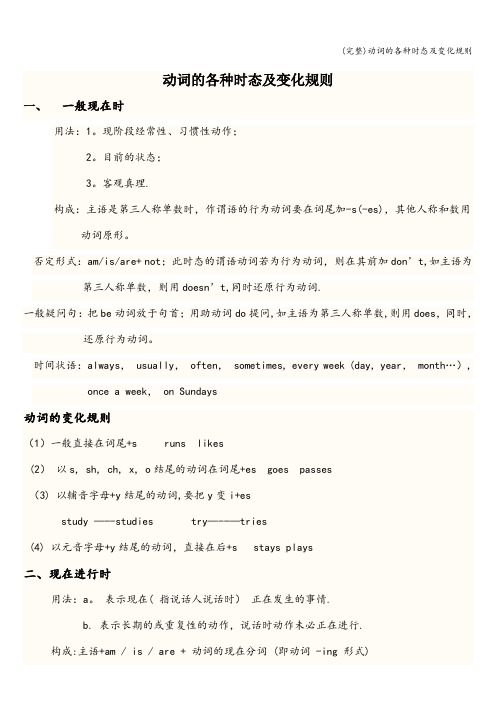
动词的各种时态及变化规则
一、一般现在时
用法:1。现阶段经常性、习惯性动作;
2。目前的状态;
3。客观真理.
构成:主语是第三人称单数时,作谓语的行为动词要在词尾加-s(-es),其他人称和数用动词原形。
否定形式:am/is/are+ not;此时态的谓语动词若为行为动词,则在其前加don’t,如主语为第三人称单数,则用doesn’t,同时还原行为动词.
一般疑问句:把be动词放于句首;用助动词do提问,如主语为第三人称单数,则用does,同时,还原行为动词。
时间状语:always, usually, often, sometimes, every week (day, year,month…), once a week, on Sundays
动词的变化规则
(1)一般直接在词尾+s runs likes
(2)以s, sh, ch, x, o结尾的动词在词尾+es goes passes
(3) 以辅音字母+y结尾的动词,要把y变i+es
study —--studies try—--—tries
(4) 以元音字母+y结尾的动词,直接在后+s stays plays
二、现在进行时
用法:a。表示现在( 指说话人说话时)正在发生的事情.
b. 表示长期的或重复性的动作,说话时动作未必正在进行.
构成:主语+am / is / are + 动词的现在分词 (即动词 -ing 形式)
否定形式:主语+am / is / are + 动词的现在分词
一般疑问句:把am / is / are放于句首。
时间状语:these days, now, at the moment, look, listen。
初中英语动词时态复习课件
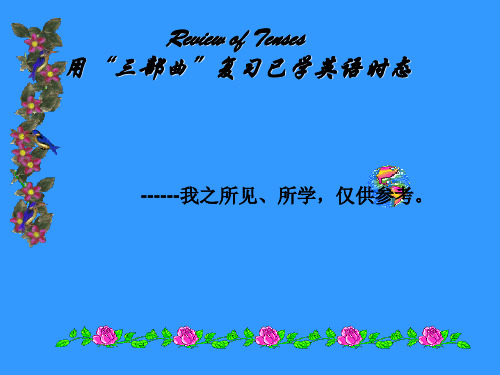
Let’s look at a picture! 乌龟说什么?
一般将来时
Let’s look at another picture! 蜗牛要为乌龟买什么?
以上两图在它们所说的句子里都用 了一个共同的时态,是什么?
是一般将来时 ,请说出 它的标志和构成:
tomorrow, tomorrow afternoon/evening.... next week/month in +一段时间
7. — How clean the bedroom is !(09,28)
— Yes, I am sure that someone _C___ it.
A cleans
B cleaned
C has cleaned
D had cleaned
请看下面两幅图
I played with my brother, then I cleaned my room.
What did you do yesterday?
小明问他的好友Tom昨天做了啥,你们 知道他做什么了吗?
Where did she go on vacation?
She visited the USA. She went to New York City.
(have) 6、Ms Green _w__a_s_c_o_o_k_i_n_gwhen I came in.
动词的各种时态归纳(含例句及解析)
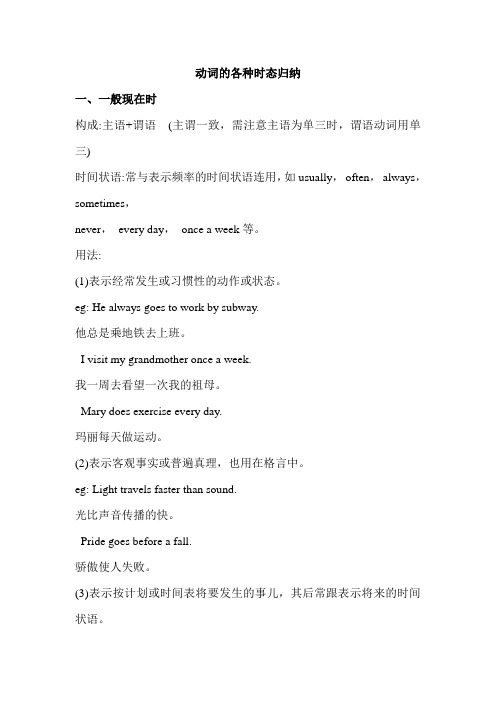
动词的各种时态归纳
一、一般现在时
构成:主语+谓语(主谓一致,需注意主语为单三时,谓语动词用单三)
时间状语:常与表示频率的时间状语连用,如usually,often,always,sometimes,
never,every day,once a week等。
用法:
(1)表示经常发生或习惯性的动作或状态。
eg: He always goes to work by subway.
他总是乘地铁去上班。
I visit my grandmother once a week.
我一周去看望一次我的祖母。
Mary does exercise every day.
玛丽每天做运动。
(2)表示客观事实或普遍真理,也用在格言中。
eg: Light travels faster than sound.
光比声音传播的快。
Pride goes before a fall.
骄傲使人失败。
(3)表示按计划或时间表将要发生的事儿,其后常跟表示将来的时间状语。
The plane takes off at four PM.
飞机下午4点起飞。
When does the school begin?
学校什么时候开学?
(4)表示主语现在的特征性格或状态。
Jenny loves music.
珍妮喜欢音乐。
She lives in a small apartment.
他住在一套小公寓里。
(5)一些表示心理意识的动词,如know,understand,remember等无进行时,只能用一般现在时表示现在发生的具体行为。
eg: I still remember the frightening experience on the island.
动词时态复习(各种时态)
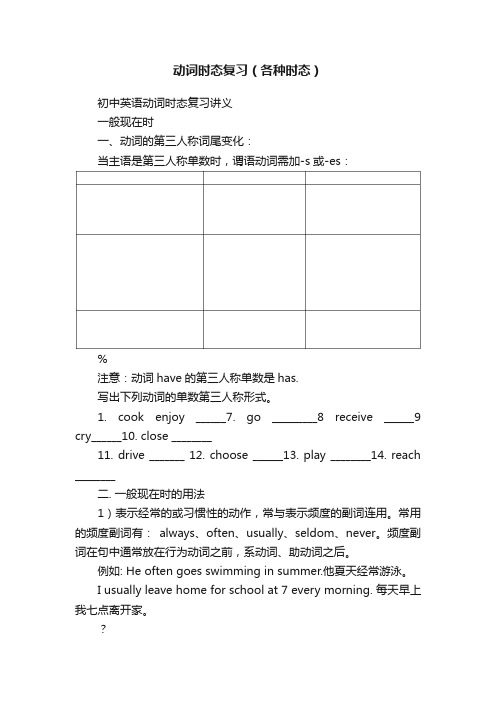
动词时态复习(各种时态)
初中英语动词时态复习讲义
一般现在时
一、动词的第三人称词尾变化:
当主语是第三人称单数时,谓语动词需加-s或-es:
%
注意:动词have的第三人称单数是has.
写出下列动词的单数第三人称形式。
1. cook enjoy ______7. go _________8 receive ______9 cry______10. close ________
11. drive _______ 12. choose ______13. play ________14. reach ________
二. 一般现在时的用法
1)表示经常的或习惯性的动作,常与表示频度的副词连用。常用的频度副词有:always、often、usually、seldom、never。频度副词在句中通常放在行为动词之前,系动词、助动词之后。
例如: He often goes swimming in summer.他夏天经常游泳。
I usually leave home for school at 7 every morning. 每天早上我七点离开家。
2)表示现在的状态。
例如:My father is at is very busy. 我父亲在工作,他很忙。
The boy is twelve. 这男孩十二岁。
3)表示主语具备的性格、特征和能力等。
例如:All my family love football .我全家人都喜欢足球。
My sister is always ready to help others . 我妹妹总是乐于助人。
初三时态复习及动词时态专项练习(基础)
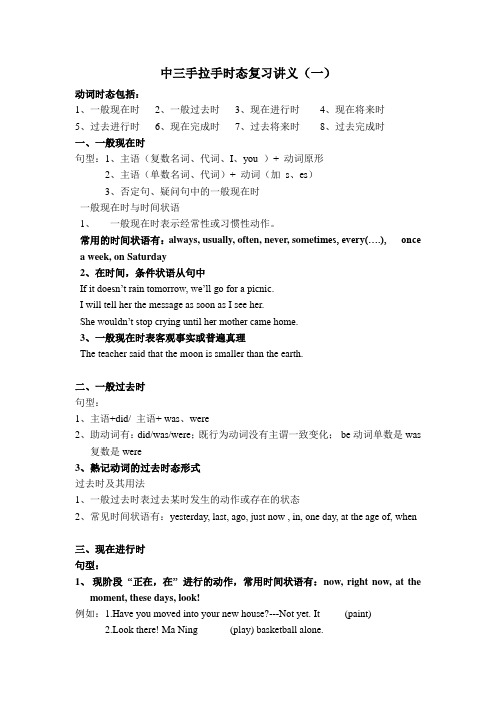
中三手拉手时态复习讲义(一)
动词时态包括:
1、一般现在时
2、一般过去时
3、现在进行时
4、现在将来时
5、过去进行时
6、现在完成时
7、过去将来时
8、过去完成时
一、一般现在时
句型:1、主语(复数名词、代词、I、you )+ 动词原形
2、主语(单数名词、代词)+ 动词(加s、es)
3、否定句、疑问句中的一般现在时
一般现在时与时间状语
1、一般现在时表示经常性或习惯性动作。
常用的时间状语有:always, usually, often, never, somet imes, every(….), once
a week, on Saturday
2、在时间,条件状语从句中
If it doesn’t rain tomorrow, we’ll go for a picnic.
I will tell her the message as soon as I see her.
She wouldn’t stop crying until her mother came home.
3、一般现在时表客观事实或普遍真理
The teacher said that the moon is smaller than the earth.
二、一般过去时
句型:
1、主语+did/ 主语+ was、were
2、助动词有:did/was/were;既行为动词没有主谓一致变化;be动词单数是was
复数是were
3、熟记动词的过去时态形式
过去时及其用法
1、一般过去时表过去某时发生的动作或存在的状态
2、常见时间状语有:yesterday, last, ago, just now , in, one day, at the age of, when
初中英语八种时态归纳复习(已做)
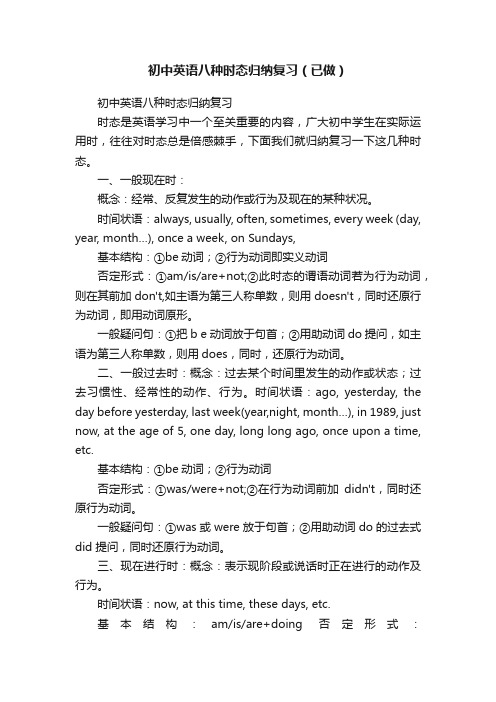
初中英语八种时态归纳复习(已做)
初中英语八种时态归纳复习
时态是英语学习中一个至关重要的内容,广大初中学生在实际运用时,往往对时态总是倍感棘手,下面我们就归纳复习一下这几种时态。
一、一般现在时:
概念:经常、反复发生的动作或行为及现在的某种状况。
时间状语:always, usually, often, sometimes, every week (day, year, month…), once a week, on Sundays,
基本结构:①be动词;②行为动词即实义动词
否定形式:①am/is/are+not;②此时态的谓语动词若为行为动词,则在其前加don't,如主语为第三人称单数,则用doesn't,同时还原行为动词,即用动词原形。
一般疑问句:①把b e动词放于句首;②用助动词do提问,如主语为第三人称单数,则用does,同时,还原行为动词。
二、一般过去时:概念:过去某个时间里发生的动作或状态;过去习惯性、经常性的动作、行为。时间状语:ago, yesterday, the day before yesterday, last week(year,night, month…), in 1989, just now, at the age of 5, one day, long long ago, once upon a time, etc.
基本结构:①be动词;②行为动词
否定形式:①was/were+not;②在行为动词前加didn't,同时还原行为动词。
一般疑问句:①was或were放于句首;②用助动词do的过去式did 提问,同时还原行为动词。
动词的时态九年级英语必考词法总复习
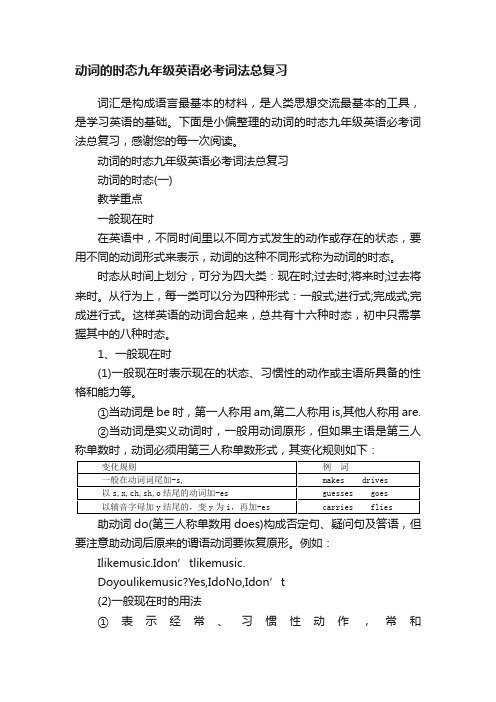
动词的时态九年级英语必考词法总复习
词汇是构成语言最基本的材料,是人类思想交流最基本的工具,是学习英语的基础。下面是小偏整理的动词的时态九年级英语必考词法总复习,感谢您的每一次阅读。
动词的时态九年级英语必考词法总复习
动词的时态(一)
教学重点
一般现在时
在英语中,不同时间里以不同方式发生的动作或存在的状态,要用不同的动词形式来表示,动词的这种不同形式称为动词的时态。
时态从时间上划分,可分为四大类:现在时;过去时;将来时;过去将来时。从行为上,每一类可以分为四种形式:一般式;进行式;完成式;完成进行式。这样英语的动词合起来,总共有十六种时态,初中只需掌握其中的八种时态。
1、一般现在时
(1)一般现在时表示现在的状态、习惯性的动作或主语所具备的性格和能力等。
①当动词是be时,第一人称用am,第二人称用is,其他人称用are.
②当动词是实义动词时,一般用动词原形,但如果主语是第三人称单数时,动词必须用第三人称单数形式,其变化规则如下:
助动词do(第三人称单数用does)构成否定句、疑问句及答语,但要注意助动词后原来的谓语动词要恢复原形。例如:
Ilikemusic.Idon’tlikemusic.
Doyoulikemusic?Yes,IdoNo,Idon’t
(2)一般现在时的用法
①表示经常、习惯性动作,常和
often,usually,everyday,sometimes,always等时间状语连用。如:Hegoestoschoolbybuseveryday.
Theyoftenplayfootball
人教版初中英语时态复习课件

例句:I am working.
例句:I was working.
小结(Summary):
做动词时态题的时候要注意以下几个方面:
1.根据时间状语确定时态 2.根据上下文已有时态信息点确定时态 3.上下文语意确定时态 4.在复合句根据时态呼应确定时态 5.时态中的“特殊”对策
1. Neither of us ______ a doctor.
D. will put on
4._____ she _____ TV at seven yesterday evening ?
A. Was…watching B. Is…watch C. Has… watched D. Will…watch
.5.He can’t go to the cinema with me because he ____ a meeting.
例如:You are always changing your mind.
你老是改变主意。
2)表示渐变,这样的动词有:get, grow, become, turn, run, go, begin等。
例如 The leaves are turning red. 叶子在变红。
It's getting warmer and warmer.
B. don't do
C. didn’t do
高考英语动词时态语态复习
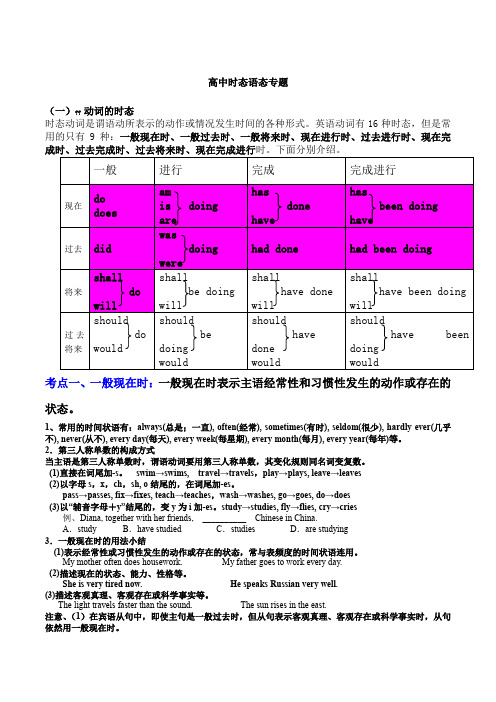
高中时态语态专题
(一)?? 动词的时态
时态动词是谓语动所表示的动作或情况发生时间的各种形式。英语动词有16种时态,但是常用的只有9种:一般现在时、一般过去时、一般将来时、现在进行时、过去进行时、现在完
考点一、一般现在时:一般现在时表示主语经常性和习惯性发生的动作或存在的
状态。
1、常用的时间状语有:always(总是;一直), often(经常), sometimes(有时), seldom(很少), hardly ever(几乎不), never(从不), every day(每天), every week(每星期), every month(每月), every year(每年)等。
2.第三人称单数的构成方式
当主语是第三人称单数时,谓语动词要用第三人称单数,其变化规则同名词变复数。
(1)直接在词尾加-s。swim→swims, travel→travels,play→plays, leave→leaves
(2)以字母s,x,ch,sh, o结尾的,在词尾加-es。
pass→passes, fix→fixes, teach→teaches,wash→washes, go→goes, do→does
(3)以“辅音字母+y”结尾的,变y为i加-es。study→studies, fly→flies, cry→cries
例、Diana, together with her friends, __________ Chinese in China.
A.study B.have studied C.studies D.are studying
时态复习精讲(一般现在时、现在进行时、将来时、过去式)

表示将来某个时间正在进行的动作,例如"She is coming to visit us next month."。
注意事项与常见错误
注意时态一致性:在复合句中,主句和从句的时态应 保持一致,不要混淆时态。
区分"will/shall"与"be going to"的用法:虽然两者 都可用于表示将来时,但"will/shall"强调的是意愿或 可能性,而"be going to"强调的是计划或预测。
注意事项与常见错误
动词ing形式的正确使用
注意动词ing形式的拼写和语法,如 “running”而不是“runing”。
时态一致性
在复合句中,主句和从句的时态应保 持一致,如“I am writing a letter while she is singing”。
避免冗余
避免在句子中同时使用现在进行时和 一般现在时,如“I am writing letters and she sings songs”。
主语+谓语+宾语
I like apples.
主语+系动词+表语
He is a student.
主语+谓语+间接宾语+直接宾 语
英语复习常见时态12种
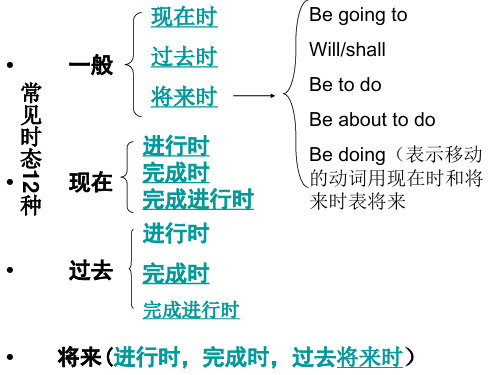
days, at the moment 一般用法1.经常性、习惯性或反复发生的动作或状态
2. 特殊句型: It’s time that+did….
I would(I’d) rather
I wish
3.有时过去时态只表示委婉的语气
Could you lend me your bike? 4.表示过去连续发生的一系列动作 5 .think, hope 等用过去时,表原以为、原希望等。 I thought you might have some. 我以为你想要一些。
三.一般将来时的常用结构
• 基本用法(教案) • 特殊用法①用于“I expect, I‘m sure, I think, I
wonder + 宾语从句”中
• Don't worry about the exam. I'm sure you'll pass. 不要担心这次考试,我确信你会通过的。
• I wonder what will happen. 我不知道将会发生 什么事。
(完整版)16种时态及语态总结

时态语态总结
说明:
1. 英语有16种时态,其中常见的有10种;
2. 一般现在时、一般过去时、一般将来时、过去将来时四种基本时态均有被动语态。
3. 现在进行时、过去进行时有被动语态,而将来进行时和过去将来进行时没有被动语态。
4. 现在完成时、过去完成时有被动语态,将来完成时和过去将来完成时很少用于被动结构。
5. 完成进行时均没有被动语态(包括现在完成进行时、过去完成进行时、将来完成进行时、过去将来完成进行时)。
注意:填充单元格为不常用时态。
▲用法及举例:
1. 一般时态的被动语态
一般时态的被动形式都由“助动词be+过去分词”构成(动作发生时间由be表现出来) (1) 一般现在时的被动语态
In China, the railways are owned by the state. 在中国,铁路是国有的。
They are asked to shoulder the costs of the repair. 要求他们承担这笔修理费。
The new drug began to operate not long after it is taken. 这种新药服用后不久就会开始见效。
(2) 一般过去时的被动语态:
Each couple was asked to complete a form. 要求每对夫妇填一张表。
The thief was handed over to the police. 这个小偷已经送交派出所了。
He was admitted into the club as a member. 他被接纳为俱乐部的会员。
总结版: 英语时态复习

3.一般过去时: Past Simple
概念: 表示过去发生的动作
结构:主语+ 动 (-ed) +… . 标志语:yesterday、... ago、
in 1992、 last week/month… They played basketball yesterday. Did they play basketball yesterday? They didn’t play basketball yesterday. He played basketball last week.
• 一般过去时的被动语态 • 结构:主语+ was/were +done(pp.)
1.The Computer game was played by them yesterday 2.Computer games were played by him yesterday. 3.I was hit by his bike last month.
• 一般将来时的被动语态
•结构:主语+will/be going to + be +done(pp.)
1.The job will be finished by him. The job will not been finished by him.
2.The jobs are going to be finished by him. Are the jobs going to be finished by him? The jobs are not going to be finished by him
英语八大时态整理归纳

英语八大时态归纳整理
时态是英语学习中一个至关重要的内容,广大初中学生在实际运用时,往往对时态总是倍感棘手,下面我们就归纳复习一下這几种时态。
一、一般现在时:
概念:经常、反复发生的动作或行为及现在的某种状况。
时间状语:always, usually, often, sometimes, every week (day, year, month…), once a week, on Sundays,
常与一般现在时连用的时间状语:
副词:always often never sometimes usually
短语:every day / week / month / year once a week每周一次hardly ever 几乎不every ten minutes 每十分钟every other ten minutes 每隔十分钟now and then 不时from time to time 不时
基本结构:①be动词;②行为动词
否定形式:①am/is/are+not;②此时态的谓语动词若为行为动词,则在其前加don't,如主语为第三人称单数,则用doesn't,同时还原行为动词。
一般疑问句:①把be动词放于句首;②用助动词do提问,如主语为第三人称单数,则用does,同时,还原行为动词。
二、一般过去时:
概念:过去某个时间里发生的动作或状态;过去习惯性、经常性的动作、行为。时间状语:ago, yesterday, the day before yesterday, last week(year, night, month…), in 1989, just now, at the age of 5, one day, long long ago, once upon a time,
动词时态复习一般现在时和一般过去时
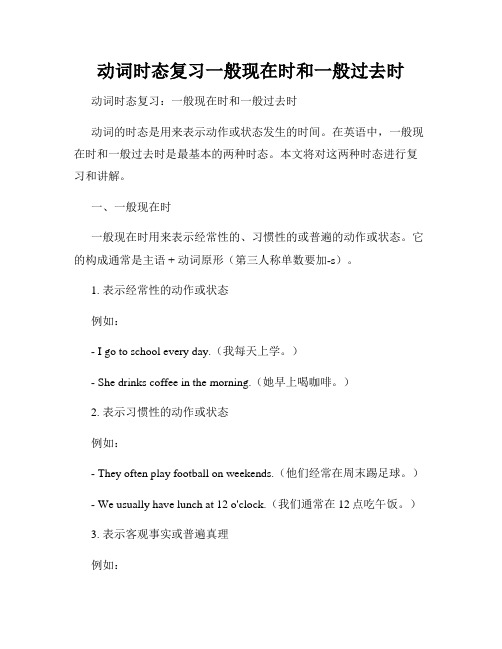
动词时态复习一般现在时和一般过去时
动词时态复习:一般现在时和一般过去时
动词的时态是用来表示动作或状态发生的时间。在英语中,一般现在时和一般过去时是最基本的两种时态。本文将对这两种时态进行复习和讲解。
一、一般现在时
一般现在时用来表示经常性的、习惯性的或普遍的动作或状态。它的构成通常是主语 + 动词原形(第三人称单数要加-s)。
1. 表示经常性的动作或状态
例如:
- I go to school every day.(我每天上学。)
- She drinks coffee in the morning.(她早上喝咖啡。)
2. 表示习惯性的动作或状态
例如:
- They often play football on weekends.(他们经常在周末踢足球。)- We usually have lunch at 12 o'clock.(我们通常在12点吃午饭。)
3. 表示客观事实或普遍真理
例如:
- The sun rises in the east.(太阳从东方升起。)
- Water boils at 100 degrees Celsius.(水在100摄氏度沸腾。)
二、一般过去时
一般过去时用来表示过去发生的动作或状态。它的构成通常是主语+ 动词过去式。
1. 表示过去的动作或状态
例如:
- I visited my grandparents last weekend.(上周末我去看望了我的祖父母。)
- She studied English for three hours yesterday.(昨天她学了三个小时英语。)
- 1、下载文档前请自行甄别文档内容的完整性,平台不提供额外的编辑、内容补充、找答案等附加服务。
- 2、"仅部分预览"的文档,不可在线预览部分如存在完整性等问题,可反馈申请退款(可完整预览的文档不适用该条件!)。
- 3、如文档侵犯您的权益,请联系客服反馈,我们会尽快为您处理(人工客服工作时间:9:00-18:30)。
初中英语动词时态复习讲义
一般现在时
一、动词的第三人称词尾变化:
当主语是第三人称单数时,谓语动词需加-s或-es:
写出下列动词的单数第三人称形式。
1. cook _______
2.watch________
3.build_________
4.have________
5.wash________
6. enjoy ______
7. go _________8 receive ______9 cry______10. close ________
11. drive _______ 12. choose ______13. play ________14. reach ________
二. 一般现在时的用法
1)表示经常的或习惯性的动作,常与表示频度的副词连用。常用的频度副词有:always、often、usually、seldom、never。频度副词在句中通常放在行为动词之前,系动词、助动词之后。
例如: He often goes swimming in summer.他夏天经常游泳。
I usually leave home for school at 7 every morning. 每天早上我七点离开家。
2)表示现在的状态。
例如:My father is at work.He is very busy. 我父亲在工作,他很忙。
The boy is twelve. 这男孩十二岁。
3)表示主语具备的性格、特征和能力等。
例如:All my family love football .我全家人都喜欢足球。
My sister is always ready to help others . 我妹妹总是乐于助人。
Ann writes good English but does not speak well. 安英语写得不错,讲的可不行。
4)表示客观真理,客观存在,自然现象。
例如:The earth moves around the sun. 地球绕太阳转动。
Shanghai lies in the east of China. 上海位于中国东部。
5)表示按计划或安排好的,或将要发生的动作,可用一般现在时表将来。但只限于start,begin,leave,go,come,arrive,return,take place等。
例如:The train leaves at six tomorrow morning. 火车明天上午六点开。
He comes back tonight. 他今晚回来。
6)在复合句中,当主句是一般将来时,时间或条件状语从句的谓语动词只能用一般现在时来表示将来要发生的动作。
例如:I'll tell him the news when he comes back. 他回来时,我将告诉他这个消息。
If you take the job , they will talk with you in greater details.
如果你接受这份工作,他们将和你谈谈细节。
巩固练习:
1、Lucy likes going skating with her friends. (改写成否定句)
________________________________________________________
2、Aunt Li’s son has ten toy bears. (对划线部分提问)
________________________________________________________
3、His watch costs 300 yuan. (变成一般疑问句并否定回答)
________________________________________________________
4、I like being a nurse for the old. (变成一般疑问句)
________________________________________________________
5、张叔叔每天乘坐地铁上班。
________________________________________________________
6、我们每周日常花三小时在图书馆看书。
________________________________________________________
7、我爷爷常常晚饭后出去散步。
________________________________________________________
一般过去时
写出下列动词的过去式形式。
1. put ________
2. drink _______
3. cry _______
4. pull ________
5. ride ________
6.begin ________
7. sit ________
8. run _________
9. take _________ 10.sweep _______
11. stop _______ 12. solve _______13. rob ________14. wait _________15. lie _________
16. turn _______17. explore _______18. drop _______19. clean ______20. produce _____
21.get __________ugh________23.pay________24.die_________25.prefer ______
二. 一般过去时的用法
1)表示过去某个时间所发生的动作或存在的状态。常和表示过去的时间状语yesterday, last week, an hour ago,just now, the other day, in 1982等连用。在一般过去式中,要表达“过多少时间之后”,一般用after。几年后。
例如:Where did you go just now? 刚才你上哪儿去了?
After a few years,she started to play the piano.几年后,她开始弹钢琴。
2)表示在过去,经常或反复发生的动作。常与often,always等表示频度的副词连用。
例如:When I was a child, I often played football in the street.
我是个孩子的时候,常在马路上踢足球。
3)一般过去式也可与today,this week,this month,this year等表现在的时间壮语连用,但这些时间壮语须指过去的时间,决不包含“现在”“此时此刻”的意思。
例如:Did you see him today?今天你看见他了吗?
巩固练习:
